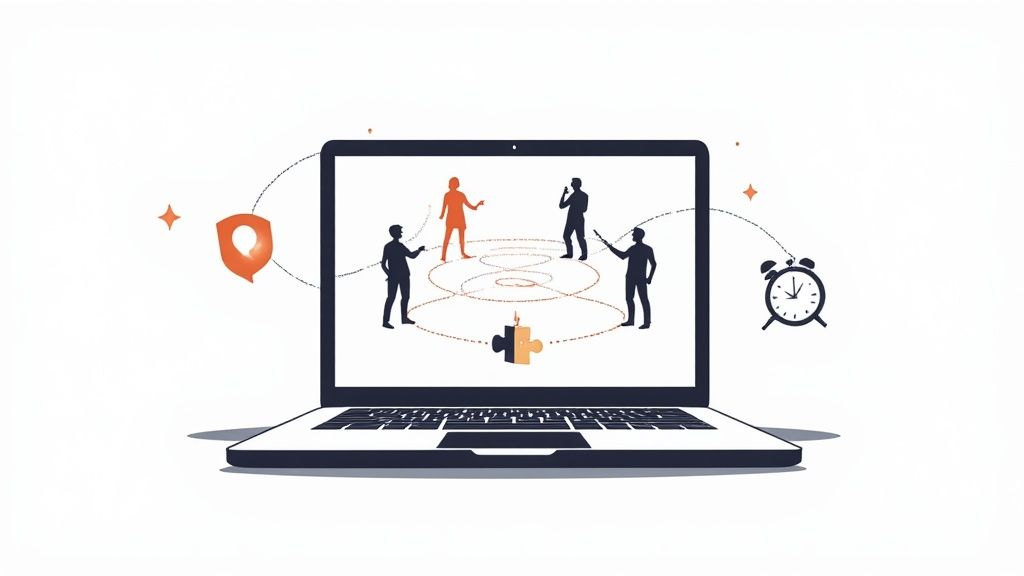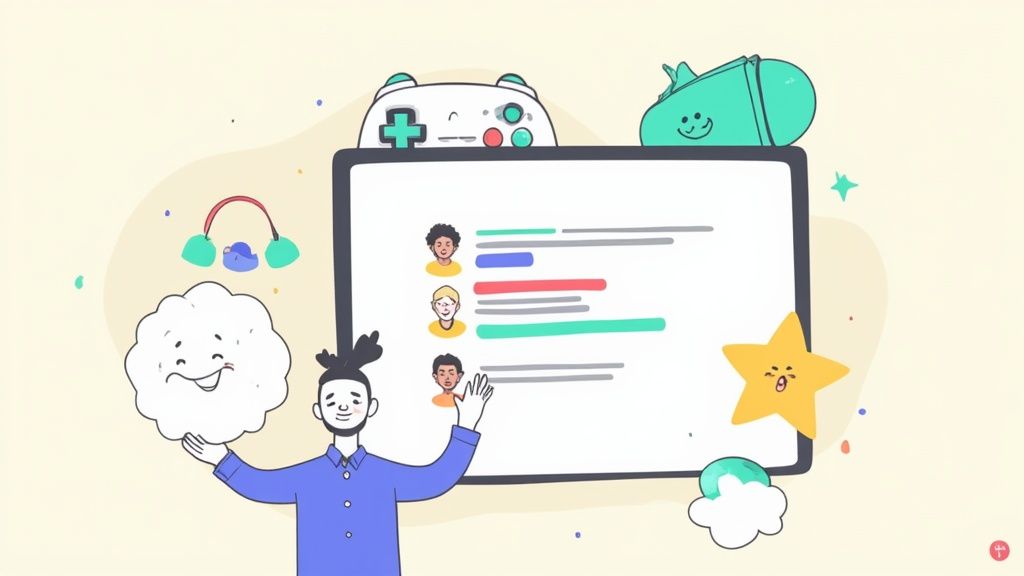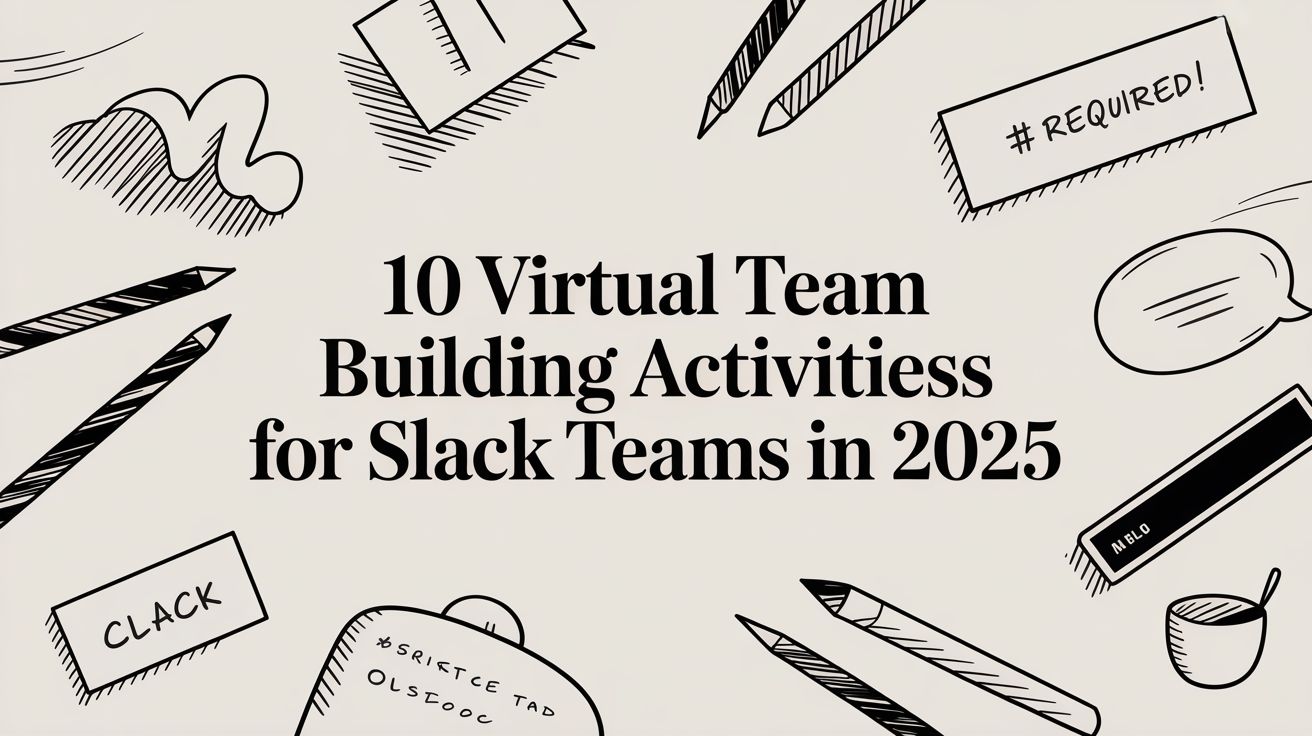In a remote-first work environment, the default “team building” often becomes another scheduled video call. While well-intentioned, these sessions can feel more like an obligation than an opportunity for genuine connection, quickly leading to screen fatigue and disengagement.
Table of Contents
The challenge for leaders is to move beyond these passive experiences and create interactive moments that build genuine rapport and strengthen team cohesion. This requires a more strategic approach, one that integrates activities directly into Slack, where work already happens.
This guide is designed to be your playbook for precisely that. We’ve compiled a comprehensive list of 10 actionable virtual team-building activities tailored for Slack-first organizations. Forget generic advice; each item in this roundup includes a step-by-step runbook with message templates, asynchronous and synchronous variations, and practical ideas for measuring impact. We’ll show you how to transform one-off events into recurring rituals that build a vibrant, connected remote culture.
A crucial component woven throughout these strategies is the power of team recognition. Acknowledging participation and celebrating small wins within these activities reinforces positive behaviors and makes team members feel genuinely valued. For example, after an activity, publicly praising a teammate for a clever idea or great collaboration doesn’t just reward them; it shows the entire team what behaviors are prized. By integrating recognition, you amplify the impact of each event, fostering a cycle of engagement and motivation. This framework is adaptable year-round, but for specific festive engagement, exploring top holiday team building activities can offer timely inspiration for remote celebrations. Prepare to discover how to cultivate a thriving team dynamic, one Slack channel at a time.
1. Virtual Escape Rooms
Virtual escape rooms are one of the most immersive and collaborative virtual team building activities available. They transport your team into a themed digital environment where they must work together against the clock to find clues, solve puzzles, and “escape” before time runs out. This activity excels at fostering real-time communication, problem-solving, and shared accomplishment.
The experience is typically hosted by a live guide over a video conference call. Your team directs the guide, who is physically in the themed room, or interacts with a purely digital interface, making decisions as a single unit to crack codes and advance the narrative. For instance, the team might have to solve a riddle to unlock a digital padlock or combine clues found by different members to reveal a hidden map.

Why Virtual Team Building Works for Remote Teams
This activity requires active participation from everyone, preventing the disengagement that can happen on standard video calls. It forces team members with different thinking styles, whether analytical or creative, to combine their strengths toward a common, high-stakes goal. The shared urgency builds camaraderie and creates a memorable experience that strengthens team bonds.
Key Insight: The immediate feedback loop of solving a puzzle together provides a powerful sense of collective achievement, a feeling that can be difficult to replicate in day-to-day remote work.
Slack Runbook & Implementation
- Group Size: 4-8 people per room
- Time Required: 60-90 minutes (including setup and debrief)
Step-by-Step Guide:
- Pre-Event Announcement (
#team-announcements):
Team Challenge Alert! Get ready to put on your detective hats! We’re doing a Virtual Escape Room on [Date] at [Time]. We’ll be tackling “[Room Name]” from [Provider, e.g., The Escape Game]. Please RSVP with a :white_check_mark: by [RSVP Date]!
- Day-Of Reminder (
#team-channel):
Our escape room adventure begins in one hour! Grab your headphones and meet us in the [Zoom/Video Link]. Let’s solve this thing!
- Post-Event Recognition: Immediately after the event, celebrate the team’s success (or valiant effort). The importance of this step cannot be overstated; it solidifies the positive experience and makes employees feel seen.
Huge shoutout to the dream team for escaping the “[Room Name]” with [Time] to spare! Special props to @[Teammate A] for cracking that final code and @[Teammate B] for keeping all our notes organized. Great collaboration, everyone!
@AsanaBot add task recognize team for escape room success
2. Online Trivia and Quiz Competitions
Online trivia and quiz competitions are classic virtual team-building activities that bring the fun and competitive energy of a pub quiz to your remote team. Using platforms like Kahoot! or dedicated trivia hosts, teams go head-to-head answering questions across categories ranging from general knowledge and pop culture to company-specific inside jokes. It’s a low-barrier, high-engagement way to spark friendly rivalry and create shared memories.
The format is simple: a host shares their screen over a video call, presents questions, and teams collaborate in breakout rooms or chat channels to submit their answers. For a practical example, a round could be themed around “Project Codewords,” where teams have to guess the project based on a cryptic clue, blending fun with company culture. Real-time leaderboards keep the energy high and the stakes fun, making it an accessible activity for everyone.
Why It Works for Remote Teams
Trivia naturally encourages communication and collaborative decision-making under light pressure. To succeed, team members must listen to each other’s suggestions, debate answers, and reach a consensus quickly. Mixing in company-specific questions (e.g., “What was our first client’s name?”) reinforces company culture and shared history in a fun, non-corporate setting. It’s a powerful way to bring different departments together and level the playing field.
Key Insight: The blend of general knowledge and company-specific trivia allows different people to shine, ensuring that every team member has a chance to be the hero who knows the winning answer.
Slack Runbook & Implementation
- Group Size: 5-50+ (can be broken into smaller teams of 4-6)
- Time Required: 45-60 minutes
Step-by-Step Guide:
- Pre-Event Announcement (
#team-announcements):
Trivia Tussle! Get your thinking caps on for our monthly Virtual Trivia Showdown on [Date] at [Time]. We’ll be using [Platform, e.g., Kahoot!] with prizes for the winning team! RSVP with a so we can create the teams!
- Day-Of Reminder (
#team-channel):
Trivia time is just 30 minutes away! Here are your teams: [List Teams and Members]. Meet us in the [Zoom/Video Link]. May the best team win!
- Post-Event Recognition: Acknowledge the winners and highlight fun moments to keep the positive energy flowing. Public recognition reinforces the value of participation and makes the event more memorable.
A massive congratulations to Team [Winning Team Name] for their trivia triumph today! A special shoutout to @[Teammate A] for their encyclopedic knowledge of 90s movies. Amazing job, everyone!
@AsanaBot add task send gift cards to trivia winners
3. Virtual Team Activity: Cooking or Mixology Classes
Virtual cooking or mixology classes are engaging, sensory-rich team-building activities that bring colleagues together in their home kitchens. Led by a professional chef or mixologist via video conference, teams follow along to prepare a meal, bake pastries, or craft cocktails. The shared experience moves beyond typical work discussions, creating a relaxed, hands-on environment.
This format allows team members to learn a new skill, share their culinary creations, and enjoy the fruits of their labor together. For example, a company might send pasta-making kits to each employee, and everyone follows the chef’s instructions to make fresh ravioli from scratch. It’s a fantastic way to bond over a universally loved activity: food and drink. This approach has been successfully adopted by companies such as Google Cloud and JPMorgan Chase to boost morale and well-being.

Why It Works for Remote Teams
Unlike passive screen-sharing activities, a cooking class requires active physical participation, making it highly engaging. It levels the professional playing field, allowing individuals to connect on a personal level as they navigate a shared, low-stakes challenge. Seeing colleagues in their home environment, perhaps with a family member helping, humanizes the team and builds authentic connections.
Key Insight: The act of creating something tangible together, like a meal or a drink, fosters a unique sense of shared accomplishment and provides a natural, relaxed topic for conversation that strengthens team cohesion.
Slack Runbook & Implementation
- Group Size: 8-15 people for optimal interaction
- Time Required: 90-120 minutes (including prep, cooking, and social time)
Step-by-Step Guide:
- Pre-Event Announcement (
#team-announcements):
:knife_fork_plate: Get Your Aprons Ready! We’re hosting a Virtual Cooking Class on [Date] at [Time]! We’ll be making [Dish Name] with an expert chef from [Provider, e.g., Sur La Table]. Ingredient kits will be shipped, so please confirm your address and RSVP by [RSVP Date]! :white_check_mark:
- Day-Of Reminder (
#team-channel):
:cocktail: Our mixology masterclass starts in one hour! Make sure your ingredients are prepped and your shakers are ready. See you at the [Zoom/Video Link]. Let’s get mixing!
- Post-Event Recognition: Encourage sharing and celebrate the results to extend the positive impact. Recognizing effort over perfection is key; it encourages future participation and builds psychological safety.
:star2: Look at these amazing creations! Huge thanks to everyone for joining our cooking class. A special shoutout to @[Teammate A] for that beautiful plating and @[Teammate B] for helping us all figure out how to properly fold the dough!
@AsanaBot add task celebrate team for successful cooking event
4. Virtual Talent Shows and Karaoke
Virtual talent shows and karaoke sessions are dynamic and personality-driven virtual team building activities that empower employees to share their hidden passions. This format provides a stage for team members to showcase skills beyond their job descriptions, from singing and playing musical instruments to stand-up comedy or magic tricks, all hosted via video conference. It’s a powerful way to celebrate individual uniqueness and build deeper personal connections.
The event can be organized as a live showcase where participants perform one by one, or as a more casual karaoke party using platforms that sync lyrics and backing tracks. For instance, a team member could share their screen to play a pre-recorded video of them performing a magic trick, or another could perform a live acoustic song. Audience members participate actively through chat, emoji reactions, and polls, creating a supportive and energetic atmosphere for the performers.
Why It Works for Remote Teams
This activity humanizes colleagues, revealing facets of their personalities that don’t surface in typical work meetings. It breaks down professional barriers and fosters psychological safety by creating a space where vulnerability is encouraged and celebrated. Seeing a manager perform a karaoke song or a quiet developer share a magic trick can dramatically shift team dynamics and build authentic camaraderie.
Key Insight: Encouraging voluntary participation in a low-pressure, supportive environment helps build a culture of appreciation where every individual’s contribution, both professional and personal, is valued.
Slack Runbook & Implementation
- Group Size: 10+ (The more, the merrier for audience energy)
- Time Required: 60-90 minutes
Step-by-Step Guide:
- Pre-Event Announcement & Performer Signup (
#team-announcements):
:microphone: Get Ready for [Company Name]’s Got Talent! We’re hosting a virtual talent show & karaoke night on [Date] at [Time]. Got a secret skill? Want to belt out a classic? Sign up to perform here: [Link to Form]. Just want to watch and cheer? RSVP with a :tada: by [RSVP Date]!
- Day-Of Reminder (
#team-channel):
:sparkles: The show starts in one hour! Get your snacks ready and prepare to be amazed by your talented colleagues. Join us here: [Zoom/Video Link]. Let’s show our performers some love!
- Post-Event Recognition: Acknowledge every single performer to reinforce the value of their participation. Recognizing courage is just as crucial as recognizing talent; this praise encourages more people to step up next time.
:trophy: A massive round of applause for all our incredible performers tonight! Huge props to @[Teammate A] for that amazing guitar solo, @[Teammate B] for the hilarious comedy set, and everyone who shared their talent. You all made this an unforgettable night!
@AsanaBot add task create highlight reel of talent show
5. Online Gaming Tournaments (Casual & Competitive)
Organized gaming tournaments are fantastic virtual team building activities that tap into the natural fun of friendly competition. These events bring teams together for structured play using accessible online games, ranging from casual party games like Jackbox to more strategic options like Among Us. The tournament format, complete with leaderboards and even live commentary, transforms a simple game into a memorable shared experience.
This approach accommodates a range of skill levels and interests by offering a mix of casual and competitive brackets. For example, you could run a company-wide tournament of Quiplash, a game where players submit witty answers to prompts, ensuring that non-gamers can participate and shine just as much as seasoned players. Companies like Procter & Gamble and Cisco have successfully used Jackbox Games’ corporate licenses to host engaging internal events, proving that gaming is a powerful tool for connection in a professional setting.

Why It Works for Remote Teams
Gaming tournaments lower the barrier to interaction by creating a relaxed, informal environment where colleagues can connect beyond work-related tasks. The competitive element encourages strategic thinking and communication, while the shared goal of winning fosters a strong sense of team identity. It provides a unique space for employees to showcase different skills and personalities, building relationships that translate back into daily collaboration.
Key Insight: A well-organized tournament creates both active participants and engaged spectators. This dual engagement allows more people to feel part of the event, even if they aren’t playing, boosting overall team morale.
Slack Runbook & Implementation
- Group Size: 8-100+ (can be scaled with multiple brackets or games)
- Time Required: 60-120 minutes per session (can be a one-off event or multi-week league)
Step-by-Step Guide:
- Pre-Event Announcement (
#team-announcements):
Game On, Team! Announcing our first-ever company-wide Jackbox Games Tournament! We’ll battle it out for glory on [Date] at [Time]. No gaming experience needed, just bring your competitive spirit! RSVP with a by [RSVP Date] to claim your spot.
- Day-Of Reminder (
#team-channel):
The tournament begins in one hour! Find the rules and brackets in the thread. Meet us in the [Video Link] for the opening ceremony. May the best gamer win!
- Post-Event Recognition: Acknowledge the winners and highlight memorable moments to reinforce the sense of community. Recognizing humorous moments or great sportsmanship is as crucial as celebrating the winner, as it emphasizes the goal of connection over competition.
A massive congratulations to @[Winner Name] for conquering the Jackbox tournament! And a special shoutout to @[Teammate A] for that unforgettable Quiplash answer and @[Teammate B] for their amazing drawing in Drawful. Thanks to everyone for playing!
@AsanaBot add task send prize to tournament winner @[Winner Name]
6. Virtual Fitness Classes and Wellness Challenges
Promoting employee well-being is a powerful way to build a supportive team culture, and virtual fitness classes are one of the most effective virtual team building activities to achieve this. These live or on-demand sessions, ranging from yoga and meditation to HIIT and dance, bring employees together to de-stress and prioritize health. Hosted over video, they create a shared, positive experience outside of work tasks.
These initiatives can be one-off classes or multi-week wellness challenges using platforms like Strava or Peloton Digital. A practical example is a month-long “Step Challenge” where teams compete to achieve the highest average daily step count, with a leaderboard shared weekly in Slack. By tracking progress and encouraging friendly competition, teams can build healthy habits together, fostering accountability and mutual support in a low-pressure environment.
Why It Works for Remote Teams
Wellness activities directly combat the sedentary nature and potential isolation of remote work. Offering a structured break for physical activity demonstrates that the company genuinely cares about its employees’ health, boosting morale and loyalty. The shared goal, whether completing a yoga class or hitting a step count, creates a unique, non-work-related connection point.
Key Insight: Investing in team wellness builds resilience. When employees feel supported physically and mentally, they are better equipped to collaborate effectively, handle stress, and stay engaged in their roles.
Slack Runbook & Implementation
- Group Size: 5-50+ (highly scalable)
- Time Required: 30-60 minutes for a class; ongoing for a challenge
Step-by-Step Guide:
- Pre-Event Announcement (
#announcements-wellness):
Time to Unwind! We’re launching our first team-wide Virtual Yoga Class on [Date] at [Time] with an instructor from [Provider, e.g., Glo]. All levels welcome! RSVP with a :yogi: to get the calendar invite.
- Day-Of Reminder (
#team-channel):
Reminder: Our virtual yoga session starts in 30 minutes. Find a comfy spot, grab your mat, and join us here: [Zoom/Video Link]. Let’s get our stretch on!
- Post-Event Recognition: Acknowledge participation and progress, especially in a long-term challenge. Celebrating consistency and effort is vital for motivation. Recognizing these contributions shows that the company values well-being as a continuous practice, not just a one-time event.
Amazing energy in our yoga session today! For our ongoing Step Challenge, a huge congratulations to @[Teammate A] for hitting 50,000 steps this week!
7. Virtual Book Clubs and Learning Circles
Virtual book clubs and learning circles are structured, recurring virtual team building activities where colleagues read the same book, article, or industry report and gather to discuss its themes. More than a simple chat, these sessions use guided facilitation to connect the content’s insights directly to work, personal development, and shared team challenges. This creates a powerful space for intellectual connection and continuous learning.
These groups, popularized by corporate L&D departments and employee resource groups, transform passive content consumption into an active, collaborative experience. For example, a marketing team might read a book on consumer psychology and then dedicate a session to brainstorming how its principles could be applied to their next campaign. Members share perspectives, challenge assumptions, and uncover new ways of thinking together, fostering a culture of curiosity and intellectual growth.
Why It Works for Remote Teams
This activity provides a unique forum for deeper, more meaningful conversations that go beyond daily tasks and project updates. It allows team members to connect on an intellectual and personal level, revealing different viewpoints and communication styles in a low-stakes environment. By exploring new ideas together, teams build a shared vocabulary and analytical framework that can improve strategic thinking and problem-solving in their day-to-day work.
Key Insight: A learning circle creates a rhythm of connection that isn’t tied to a project deadline. This consistency builds psychological safety and trust, encouraging more candid and innovative discussions over time.
Slack Runbook & Implementation
- Group Size: 5-10 people
- Time Required: 45-60 minutes per session (bi-weekly or monthly)
Step-by-Step Guide:
- Launch Poll (
#team-channel): Gauge interest and select the first book.
:books: New Team Initiative: Let’s start a Book Club! We’ll read one book per quarter to grow together. Vote on our first read below!
:one: Atomic Habits by James Clear
:two: Dare to Lead by Brené Brown
:three: The Five Dysfunctions of a Team by Patrick Lencioni - Kick-Off Announcement (
#book-club-channel): Create a dedicated channel and share the schedule.
Welcome to our first Learning Circle! We’re reading Atomic Habits.
Reading Goal: Chapters 1-5
First Meeting: [Date] at [Time] in [Zoom/Video Link]
Let’s share interesting quotes or thoughts here as we read! - Post-Discussion Recognition: Acknowledge key contributions and share a summary. Recognizing insightful comments encourages deeper reading and more thoughtful participation in future sessions. To maximize engagement and foster meaningful dialogue within your virtual book club, consider using these top book club discussion questions.
:bulb: Fantastic discussion today! Thanks to @[Teammate A] for the great point about habit stacking for our marketing workflows, and @[Teammate B] for facilitating. Key takeaway: Small, consistent improvements are our new superpower.
@AsanaBot add task research habit stacking tools for team
8. Speed networking and Virtual Coffee Chats
Speed networking and virtual coffee chats are structured, informal virtual team building activities designed to forge personal connections across an organization. These sessions intentionally pair colleagues who may not interact in their daily roles, breaking down departmental silos and fostering a more cohesive company culture. The format can range from rapid-fire breakout rooms to more relaxed one-on-one virtual coffee meetups.
This is typically facilitated through automated Slack apps like Donut or Coffee Roulette, which randomly pair employees for a short chat. For a more structured event, you can use breakout rooms in a video conference call, rotating participants every 5-10 minutes with conversation prompts to guide them. A practical prompt could be, “Share one tool you couldn’t do your job without, and why.”
Why It Works for Remote Teams
Remote work can make spontaneous “watercooler” conversations nearly impossible, leading to a disconnected workforce in which employees know only their immediate teammates. Virtual coffee chats recreate these moments of serendipity, helping to build trust and empathy across the entire company. Mixing seniority levels and departments provides junior employees with valuable visibility and senior staff with fresh perspectives from the front lines.
Key Insight: These low-pressure, one-on-one interactions are powerful for building psychological safety. An employee is more likely to collaborate with or ask for help from someone they’ve shared a non-work-related conversation with.
Slack Runbook & Implementation
- Group Size: 2 people per chat (unlimited pairs), or 10-50+ for speed networking events
- Time Required: 15-30 minutes per coffee chat; 45-60 minutes for a speed networking session
Step-by-Step Guide:
- Pre-Event Announcement (
#announcementsor a dedicated#coffee-buddieschannel):
:coffee: Let’s Connect! We’re launching our Virtual Coffee Chat program to help everyone get to know their amazing colleagues. We’ll be using [Donut App/Scheduling Tool] to pair you up randomly each week. Opt-in by joining the
#coffee-buddieschannel by [Date]! - Day-of-Reminder (for a specific event, in
#team-channel):
Speed Networking in 30! Time to meet some new faces. We’ll be doing quick 5-minute rounds. Grab your beverage of choice and join us at [Zoom/Video Link]. Prompts will be in the chat!
- Post-Event Recognition: Encourage sharing and celebrate the new connections made. Recognizing these interactions signals that the company values cross-departmental relationships, encouraging more people to opt in and participate actively.
Shoutout to everyone who participated in our coffee chats this week! It was great seeing new connections being made. Special thanks to @[Teammate A] for sharing that incredible book recommendation with their coffee buddy!
9. Collaborative Creative Projects and Hackathons
Collaborative creative projects and hackathons are intense, time-bound virtual team building activities that challenge teams to innovate under pressure. Groups collaborate to create something new, whether it’s designing a logo, writing a short story, building a functional prototype, or solving a pressing business problem. These events channel competitive and creative energy into tangible outcomes, fostering deep collaboration.
Inspired by the tech industry’s innovation culture, like Google’s internal events that spawned products like Gmail, these sessions are structured sprints of creativity. A practical example for a non-tech company could be a “marketing hackathon” where teams have 24 hours to develop and pitch a whole campaign for a fictional product. A virtual hackathon might span 24-48 hours, culminating in presentations and judging, while a creative project could unfold over a week with regular check-ins.
Why It Works for Remote Teams
Hackathons break down departmental silos by assembling diverse teams from engineering, marketing, design, and sales. This cross-pollination of ideas encourages a holistic approach to problem-solving and exposes team members to different perspectives. The high-energy, goal-oriented environment creates powerful bonds and a shared sense of purpose that transcends daily tasks. Even smaller teams can benefit from this focused collaboration; you can learn more about team-building activities for small groups and adapt the hackathon concept.
Key Insight: The act of building something tangible together in a short time frame creates a powerful “we did this” moment, boosting collective confidence and demonstrating the team’s potential for innovation.
Slack Runbook & Implementation
- Group Size: 4-6 people per project team
- Time Required: 24-48 hours (for a hackathon) or 1-2 weeks (for a creative project)
Step-by-Step Guide:
- Pre-Event Kickoff (
#hackathon-announcement):
Innovation Challenge: Announcing Our First Virtual Hackathon! From [Start Date] to [End Date], we’ll be tackling [Challenge Theme]. Form your teams (4-6 people) and get ready to build something amazing. Full brief and judging criteria are in the thread. Let the brainstorming begin!
- During-Event Communication (Team’s Private Channel
_proj-team-alpha_):
Quick check-in, team! We’re 4 hours in. How’s progress on the prototype? @[Teammate A], can you share the latest mockups? Let’s sync up in 15 mins on our huddle.
- Post-Event Recognition (
#company-wide):
And the winner of the Hackathon is… Team Phoenix! Huge congratulations to @[Teammate A], @[Teammate B], and @[Teammate C] for their incredible work on [Project Name]. Their presentation was outstanding! Recognizing not just the winners but all participating teams is crucial for maintaining morale and encouraging future innovation. We’ll be scheduling a follow-up to discuss how we can implement their idea.
10. Online Mentorship and Reverse Mentoring Programs
Formal mentorship programs are powerful long-term virtual team building activities that foster deep professional relationships and accelerate skill development. These programs pair experienced employees with junior staff (mentorship) or, in a reverse model, pair younger, tech-savvy employees with senior leaders to share new perspectives and digital skills. This structured approach moves beyond casual chats, creating a framework for growth, knowledge transfer, and cross-departmental connection.
Unlike one-off events, a mentorship program is an ongoing commitment. It typically involves regular scheduled calls, shared goal-setting frameworks, and organizational support to ensure both mentor and mentee benefit. For example, a mentee might work with their mentor to develop a 6-month plan to improve their public speaking skills, culminating in them presenting at a company all-hands. Companies like Microsoft and Deloitte have successfully used these programs to connect thousands of employees, breaking down silos in a remote environment.
Why It Works for Remote Teams
In a remote setting, organic opportunities for mentorship are scarce. A structured program intentionally creates the space for these vital connections to form. It helps junior employees feel supported and see a clear growth path, while giving senior staff a chance to develop leadership skills and stay connected to the company’s evolving pulse. It directly combats the isolation that can hinder career progression in distributed teams.
Key Insight: Reverse mentoring is especially potent for virtual teams, as it empowers digital natives to share their expertise on remote collaboration tools and workflows, directly improving the entire organization’s operational efficiency.
Slack Runbook & Implementation
- Group Size: Pairs (1-on-1)
- Time Required: 30-60 minutes per month, over a 6-12 month period
Step-by-Step Guide:
- Program Kick-Off (
#announcements):
Announcing Our New Mentorship Program! We’re launching a program to connect team members for professional growth. Whether you want to be a mentor or find one, fill out our matching survey by [Date]. Let’s help each other grow! [Link to Survey]
- Pair Introduction (Private DM): Create a direct message group for each pair to facilitate the initial connection.
Welcome, @[Mentor] and @[Mentee]! We’re excited to pair you for the next six months. Your first step is to schedule a 30-minute intro call to discuss goals. Here is a [Link to Discussion Guide] to help you get started!
- Post-Milestone Recognition: After a few months, celebrate progress and encourage continued participation. Giving public praise and recognition is key. Publicly recognizing a successful mentorship pairing shows the value the company places on development, encouraging broader participation.
A huge thank you to all our Q2 mentors and mentees! Special shoutout to the pair @[Mentee Name] and @[Mentor Name] for their work on the [Project/Skill] initiative. Your dedication is building a stronger team!
@AsanaBot add task share positive feedback with mentorship program participantsFind great ways to phrase your praise by reviewing these positive feedback examples.
Comparison of 10 Virtual Team-Building Activities
| Activity | Implementation Complexity 🔄 | Resource Requirements ⚡ | Expected Outcomes 📊 | Ideal Use Cases 💡 | Key Advantages ⭐ |
|---|---|---|---|---|---|
| Virtual Escape Rooms | Medium–High 🔄🔄🔄 — provider setup + tech integration | Moderate cost (often $20–$50 pp), stable internet, host | Improved real-time collaboration, problem-solving; clear success metrics | Problem-solving teams, medium–large groups, competitive events | Immersive engagement; measurable outcomes |
| Online Trivia & Quiz Competitions | Low 🔄 — minimal setup, reusable question sets | Low cost; basic polling/trivia platforms; one host | Broad participation, quick engagement, light knowledge reinforcement | Large groups, regular casual engagement, all-hands socials | Accessible, scalable, inexpensive |
| Virtual Cooking / Mixology Classes | Medium 🔄🔄 — logistics + instructor coordination | High (ingredient kits $50–$150 pp possible), kitchen equipment, instructor | Relaxed bonding, creative expression, tangible takeaways | Wellness-focused teams, small–medium groups, social events | Shared experiential activity; informal atmosphere |
| Virtual Talent Shows & Karaoke | Low 🔄 — signup + basic tech checks | Low cost; video platforms, optional karaoke tools | Boosted morale, celebration of personality, memorable moments | Creative teams, morale-boosting occasions, all company sizes | Low cost; high memorability; builds psychological safety |
| Online Gaming Tournaments | Medium 🔄🔄 — brackets, streaming, moderation | Moderate (games/platforms, streaming tools), coordinator | High engagement for gamers, competitive team dynamics, recurring engagement | Gaming-savvy teams, competitive cultures, younger demographics | Very engaging; spectator appeal; scalable |
| Virtual Fitness Classes & Wellness Challenges | Low–Medium 🔄🔄 — scheduling + instructor sourcing | Moderate (instructor fees, platform integrations), variable equipment | Improved well-being, increased energy/morale, measurable participation | Health-prioritizing organizations, long-term wellness programs | Promotes health; sustainable engagement via gamification |
| Virtual Book Clubs & Learning Circles | Low–Medium 🔄🔄 — facilitation and cadence planning | Low (books, facilitator time), optional learning platform | Deeper discussion, knowledge sharing, psychological safety | Knowledge-worker teams, learning cultures, inclusive groups | Intellectual engagement; strong for introverts |
| Speed Networking & Virtual Coffee Chats | Low 🔄 — automated matching or short rotations | Low (matching tool or calendar coordination) | Broader networks, quick connections, reduced silos | Remote-first orgs, large companies, silo-breaking initiatives | Scalable, low-effort, fosters unexpected connections |
| Collaborative Creative Projects & Hackathons | High 🔄🔄🔄 — intensive coordination, judging, follow-up | High (time commitment, collaboration tools, facilitation) | Tangible outputs, innovation, skill development, cross-functional bonds | Product/innovation-focused orgs, cross-functional teams | Drives innovation; produces usable deliverables |
| Online Mentorship & Reverse Mentoring Programs | Medium 🔄🔄 — matching, training, ongoing management | Low–Moderate (HR platform, mentor training, admin time) | Long-term development, retention, knowledge transfer | Leadership development, retention-focused orgs, all sizes | Deep professional impact; builds leadership pipeline |
From Activities to Culture: Making Recognition a Daily Habit
This guide has explored a comprehensive suite of virtual team building activities, from the collaborative puzzle-solving of escape rooms to the creative energy of online hackathons. We’ve provided detailed runbooks, Slack-native templates, and asynchronous variations to ensure you can execute these events flawlessly, no matter your team’s structure or time zone. Yet, the true power of these initiatives isn’t confined to a single scheduled hour on the calendar. Their ultimate purpose is to act as a catalyst, sparking connections that must be nurtured to build a thriving, long-lasting remote culture.
The most successful remote teams understand that one-off events are merely the starting point. The real goal is to transition from scheduled fun to a continuous, self-sustaining ecosystem of appreciation and connection. Think of it this way: a virtual trivia night is a great way to discover that your lead engineer is a history buff, but a culture of recognition is what empowers a teammate to publicly thank them for their deep knowledge in a project meeting a week later. The activity creates the opening; the culture makes the connection stick. Recognizing team members for their contributions—both inside and outside of formal activities—is the single most effective way to reinforce positive behaviors and build a supportive environment.
Bridging the Gap Between Events and Everyday Engagement
The key to a vibrant remote culture lies in making appreciation an effortless, daily habit rather than a sporadic, top-down mandate. The activities in this article build foundational trust and camaraderie, but daily reinforcement of positive behaviors solidifies it. When recognition is woven directly into your primary communication platform, like Slack, it becomes a natural part of the workflow.
This shift transforms engagement from a periodic initiative into a constant, positive feedback loop. A simple act of acknowledging a colleague’s help on a challenging problem, celebrating a project milestone, or highlighting someone who went the extra mile becomes a visible, valued part of your team’s interaction. This is where the barrier between “team building” and “daily work” dissolves. For instance, creating a dedicated #wins or A #shoutouts channel where anyone can post a thank you note creates a living archive of positive contributions, boosting morale and making everyone’s hard work visible.
Actionable Takeaways for Sustainable Team Cohesion
To ensure the positive momentum from your virtual team building activities endures, focus on integrating these principles into your team’s operational rhythm:
- Systematize Recognition: Don’t leave appreciation to chance. Implement a lightweight, intuitive Slack system that enables easy peer-to-peer recognition. This makes giving praise as simple as adding an emoji reaction to a message, lowering the barrier to entry and encouraging frequent use.
- Connect Recognition to Impact: Encourage team members to be specific in their praise. Instead of a generic “good job,” guide them toward comments like, “Thanks for catching that bug before deployment; you saved us a major headache.” This ties positive reinforcement directly to tangible business outcomes.
- Track and Learn: Use recognition data as a culture-building tool. By observing who is frequently praised, you can identify your team’s natural mentors, unsung heroes, and key connectors. This insight is invaluable for understanding team dynamics and identifying future leaders.
- Make It Rewarding: Link your recognition system to tangible rewards, whether it’s a small coffee stipend, company swag, or a contribution to a charity of their choice. This completes the positive feedback loop and shows that the organization formally values the collaborative behaviors being recognized.
Ultimately, mastering the art of remote team building is about more than just finding the perfect online game. It’s about architecting an environment where every team member feels seen, valued, and connected to a shared purpose. By combining engaging, structured virtual team building activities with a seamless, integrated system for daily recognition, you move beyond temporary morale boosts and begin building a resilient, high-performing, and genuinely cohesive remote culture that can weather any storm.
Ready to transform one-time activities into an everyday culture of appreciation? AsanteBot integrates directly into your Slack workspace, allowing your team to give and receive recognition points with a simple emoji, turning positive reinforcement into a seamless daily habit. Start building a more connected and motivated team today by exploring AsanteBot.




